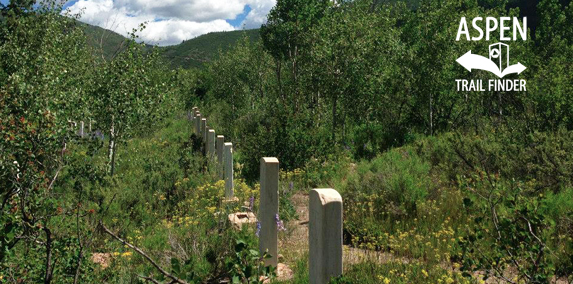Connects: Ute Avenue Trail, Wheeler Ditch Trail, Ute Park, Ute Trail
![]()
![]()
![]()
Aspen, CO – Cemetery
Ute Cemetery is a historic cemetery established in 1880 in Aspen, CO. The Ute Cemetery is listed on the National Register of Historic Places.
More information about Ute Cemetery can be found at:
National Register of Historic Places – Ute Cemetery
City of Aspen – Ute Cemetery
Wikipedia – Ute Cemetery
Park Hours are from sunrise to sunset.
Dogs mush be leashed at all times.
Bikes and motor vehicles are prohibited, except for maintenance.
Please keep nice and activity to a minimum.
Please stay on designated paths.
Hunting, camping and equestrian use is prohibited.
For your safety and out of respect, do not lean on or push on any gravestones.
The use of alcohol is prohibited.
Gravestone rubbing is permitted, please see brochure for detail.
City of Aspen Parks & Open Space”
Aspen’s two other cemeteries, Aspen Grove and Red Butte, are different from Ute Cemetery in that they were both designed to follow a grid pattern and contain the graves of those citizens who achieved wealth and status during their lives. These two cemeteries are filled with the names of mine owners, mayors, attorneys, engineers, and prominent business owners. By comparison, Ute Cemetery was clearly used as a burial ground for those early residents who lived without fame or fortune, served in modest roles during the early days of Aspen’s history, and ended their lives at this location. Many were single men who lived and died in this high altitude setting while working to develop one of the country’s newest mining districts.
A clear indication of the site’s use as a cemetery for the working class and indigent is the lack of a plan that would have allowed visitors to visit the property in carriages or wagons, the random scattering of graves throughout the property, the modest nature of the headstones and wood enclosures, and the numerous unidentified graves filled with the remains of unmarried miners and the town’s poorest residents. Even into the 20th century, most of the individuals known to be buried at Ute Cemetery appear to have received funerals at public expense.
Ute Cemetery is thus a testament to the numerous working-class people who settled in Aspen during its early years and upon whose labor the town thrived as a leading silver-producing center. The site provides the modern .visitor and historian with information about who these pioneers were, how they lived their lives, and in what way they met their deaths. The characteristics of Ute Cemetery also speak about the social history of a nascent silver-mining community and how it handled the inevitable deaths and necessities of burial. Ute Cemetery meets the requirements of Criteria Consideration D, due to its use as Aspen’s first burial ground and its association with the settlement of the town and the surrounding mining district.
The cemetery’s period of significance begins in 1880 when the first burial took place, and ends in 1930 at the termination of its period of intensive use.”

























